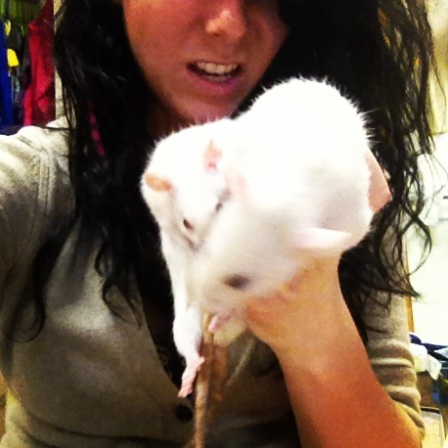They live in the deepest and darkest places on earth, crawling through filth and sewers, praying on the decomposing flesh. They spread disease and chaos globally, and are single handedly responsible for the death of 4 million people during the bubonic plague of 1348. They cause you to squirm, squeal and look the other way and I hold them personally responsible for causing my mom to scream bloody murder on the streets of New York City. Of course I am talking about rats.
While rats are made out to be cold blooded killers, for the most part they don’t live up to their reputation. Si-Fi channel has us sitting here believing that all rats are six feet long and eat small children for breakfast. Even though I have some cousins I would like to feed to six foot long rats, they are almost as fictitious as the Blob.
Rats may be my mother’s mortal enemy (not just rats, any rodent, bird, snake, small dirty child), rats can be a psychologist best friend. In my Learning Psychology lab, my lab partner and I work with a rat and are beginning to train her (you can read my rat blog post here). But what makes these squirmy little hairballs a psychologist best friend? What makes a rat’s brain similar to humans? And why is it that so many rats are used in studies and then generalized to humans?
To start I would like to tell you about something I saw on the news the other day. First of all we all know how addicting Oreos are, you eat one, you eat two, before you know it you are online signing up for a gym membership because you ate the whole box. An article I found this week says that Oreos are as addictive as cocaine. To test this they put rats in a maze, one side got Oreos, and the other got less tasty rice cakes. When the rats were set free to explore scientist recorded the amount of time the rat spent on each side of the maze. This time was compared to a study where the rats were given an injection of cocaine or an injection of saline. The researchers found that the Oreos excited the brain’s pleasure center in the same way the cocaine did (Wilson, 2013).
Now while I am sitting here contemplating my apparent drug addiction, I am also contemplating why researchers would use rats over lions or tigers or bears OH MY! There has to some explanation to why rats are used over every other animal.
One reason why rats are used in experiments is because they are mammals, as are humans. Rats systems should react in the same way as humans, if it is safe for a rat, it should be safe for humans. Another reason that rats are good test subjects is for longitudinal studies. Rats can have litters within 20 days of being born, and generally have large litters. This allows scientists to do study’s and look at how a drug, chemical or reaction could affect people over multi generations (“Why are rats,” 2013).
But how does a rat brain compare to a humans brain? How can something so small and fluffy bring us so much knowledge?!?
Typically scientists have been able to link rat nervous systems to human nervous systems due to how they develop. Rat brains and human brains match at seven stages of development allowing the development of rat brains to be compared to humans (“Human-rat comparissons,” 2013). An interactive map of this can be seen (and played) here. This allows you to see that rats have the same components of the brain that humans have just in different areas (Martin).
These masters of the sewers, these dark shadows in the night, these blood sucking vermin, are not really all that bad. Being mammals and having similar brain structures allow us to perform test on these fluff balls and get results as if they were humans. So rats are not all bad, even if they are addicted to Oreos, or cocaine.
My high school psychology teacher made us memorize this song at one point.
Work Cited:
Human-rat comparissons. (2013). Retrieved from http://neurondevelopment.org/human-rat-comparisons/
Martin, V. (n.d.). Comparison between the human and rat brain. Retrieved from http://www.wesapiens.org/file/3401005/Comparison between the human and rat brain
Why are rats used in animal testing. (2013). Retrieved from http://www.wisegeek.org/why-are-rats-used-in-animal-testing.htm
Wilson, J. (2013, October 16). Study: Oreos as addictive as cocaine. WFMZ 69 News. Retrieved from http://www.wfmz.com/study-oreos-as-addictive-as-cocaine/-/121798/22468704/-/cig51p/-/index.html




I used to breed rats for fun as a teenager. After so many litters they’d form mutations because of becoming so inbred. This could also be another reason they are used. Because they are inbred they are practically identical which can better help experiments in that there are fewer variables that could affect the findings of the hypothesis. They are cute little things.
I really learned a lot form your blog. I didn’t know that rat and human brains are so alike. I learned from your blog that both have some of the similar basic constructions. I often wondered why rats are frequently used to learn about human brain disorders. I am looking forward to your next blog.
I admit I would say I am like your mother. I hate rats, mice, & pretty much every rodent. Give me a room full of gigantic snakes any day over one rat or mouse. However, they are a benefit to the psychology community. I always wondered why they used rats over any other animal. I did not realize that their brains are so similar to ours. I learned a lot from your blog, especially since I have never worked with rats or even chose to be near them. I, also, read that article about Oreos being as addicting as cocaine. While I have never tried cocaine, I could probably finish an entire box of Oreos in one sitting!
The video at the end was perfect!!
I like the angle you took about how everyone thinks that rats are gross and dirty and just plain bad. But if you’re a psychologist than you know different. This was a great blog entry. Also, the anecdote with the Oreos was funny.
This blog was awesome and extremely informative. I always wondered why rats were used the most. In one of my other classes we talk about cat experiments which absolutely breaks my heart since I am such a crazy cat lady. I honestly believed that rats and mice were used because there is such an over abundance in them in the world. I never really realized that we, as humans, could have so much in common with them. I must be very similar to rats since I suffer from an Oreo addiction too! I work in a daycare and we give out cookies for birthdays. We usually have sugar, chocolate chip, and Oreo. Oreo is always picked the most. I should probably start letting parents know that they are so addicting like cocaine. If more people knew about that there would probably be a decline in Oreo sales!
Your blog was very informative. I am not thrilled with the sight of rats, but I would LOVE to have the opportunity to experiment with them. It is interesting that the brains of rats are so similar to humans. Especially since humans overall have such a negative disposition towards rats. They have been such a benefit to the scientific community, they deserve their props! And I wonder what make Oreos so addicting? It’s quite terrifying to hear they are just as addictive as cocaine. I wonder what ingredient makes them so addictive, or is a combination of the ingredients? Hmmm, very interesting. I’m still eating Oreos though!!
This blog was very informative and entertaining (love that video). It is nice to be able to confirm the similarities between the brain of a rat and that of a human. I am a neuroscience major and we are only able to use our cichlid fish for research. Rats would open up a lot of research questions that we cant explore in cichlids. I also think that, perhaps, it is a good thing that rats are seen in such a negative light. There would be a lot more controversy in using rats in research if they were a common family house pet.
Few animals elicit such strong and contradictory reactions as rats. Those who keep rats as pets know them as highly intelligent and social animals who clean themselves regularly and thrive on regular interaction. Yet millions of rats are used each year in research experiments and the vast majority are not covered by the Animal Welfare Act.I rat can be scary and sometimes intimidating and violent cause there are rats that bite. Although I do sympathize with rats and mice, it is hard to deny that they do pose problems to humans. They are known to carry diseases and disrupt food supplies among other things which are valid reasons to set up methods to remove them from close proximity to humans and to control their number.But they are usefull in helping with scientific research not that its ok but very informative blog.
The greatest image in my life is now the picture of a rat tweaked out on Oreos. I must say I’m glad I read this though. I’ve always wondered why our professors say we use rats due to their similarities to humans, but I never understood HOW they were alike. Also, now I feel bad. A week or so ago, my brother told me this story was in the news, and I kept calling B.S.. I guess I have some apologizing to do now… Hehe… So is it a chemical in the cookie that is similar to cocaine, or is it just the brain’s response to it that’s similar? Also, I’m proud to say I’ve been clean of Oreos for 4 years now! Once you start, it’s all downhill from there, man.
When they cay that Oreos are as addictive as cocaine, from what I understand they mean that Oreos light up the same pleasure areas in the brain as cocaine,
Aha! So give your teens Oreos. That way, when they’re offered drugs, they can pass and say they have something better. (Hahaha!) Thanks. This post made my day. 🙂
I loved the video! It reminded me of when I was a little kid! Next year I’ll hopefully be taking Learning and although I’m not a fan of rats I feel like the benefits they provide to us as psychological test subjects outweigh the grossness! I knew their brains were close to ours, but not that close! It seems they are conveniently tailored to our research needs! Good blog! Also, I wasn’t ever a huge fan of Oreos, but my mom is and I can’t wait to show her your blog!